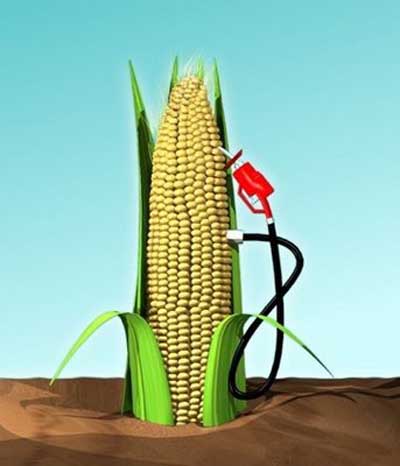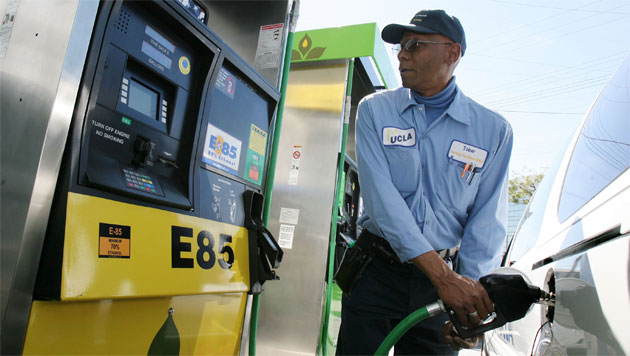We don't hear so much about ethanol these days, now that gasoline is back down to $2.50 a gallon. But we still get e-mails, so here's a post to answer the question: What's going on with flex-fuel cars?
Short answer: Manufacturers are slowly increasing the number of vehicles they build that can handle both gasoline and ethanol. The problem is the availability of the fuel.
Burning whatever's in the tank
Flex-fuel cars are designed to run on any liquid fuel you may happen to put in the tank (although not diesel). Outside the U.S., Ford offers a flex-fuel Mondeo sedan.

Corn Ethanol Pump

E85 fueling station

Entire Hummer fleet to be E85 capable by 2010

Ethanol-powered Saab diesel on display in Sweden

Volvo's entire range gets flex-fuel option
Even more remarkable, the Fiat Siena Tetrafuel sold in Brazil runs on any mix of gasoline or ethanol and also burns compressed natural gas (CNG).
Flex-fuel full size
U.S. automakers have slowly been expanding their offerings of flex-fuel-capable vehicles, although it's only in the last three or four years that they have been visibly identified as such.
The industry as a whole has now built more than 7 million flex-fuel vehicles, half of those from General Motors. And in March 2006, the Detroit Three agreed to make half the vehicles they built capable of running on E85 by 2012.
Congress is now considering a bill, sponsored by Sen. Sam Brownback (R-KS), that would require automakers to make 80 percent of their fleet E85-compatible by 2015. The comparable House bill is sponsored by Rep. Eliot Engel (D-NY).
CAFE credits for carmakers
It's worth noting that for many years, carmakers could get EPA credits toward meeting Corporate Average Fuel Economy standards simply by building flex-fuel vehicles.
No matter if not a single drop of ethanol ever gurgled through their fuel lines--and it virtually never did--they still got the credits. It wasn't until gas prices spiked a few years ago that the yellow fuel cap to denote a flex-fuel vehicle came into being.
Under the EPA's latest emissions requirements, those credits would continue through 2015. After that, automakers would only get credit if they could show E85 was actually being used.
GM and Ford lead, imports trail
General Motors and Ford offer flex-fuel abilities mostly in their largest vehicles. For 2010, GM's full-size vans, pickup trucks, and sport utility vehicles, and a few full-size, midsize and compact cars have flex-fuel hardware built in.
Ford similarly offers flex-fuel large pickup trucks and sport-utilities, as well as full-size sedans. By and large, however, import nameplates are moving far less aggressively.
E85 struggles for access
The real problem today is availability of alternative fuels. The ethanol blend known as E85 is sold only at a few hundred Midwestern gas stations, mostly local or regional brands.
E85 isn't blended by the oil companies whose names are on more than half the gas stations in the U.S. So there's little business case for them to allow a "foreign" fuel onto their real estate, even if someone else were to pay the cost of installing new and separate tanks and pumps.
Not price competitive
And because a gallon of E85 has less energy than a gallon of E10 gasoline, it has to be priced substantially lower than gasoline for buyers to come out even.
That was possible at the height of the 2007 gasoline spike, with prices of $4 a gallon or more. Now that gasoline has fallen back to levels of $2.50 or $3.00 a gallon, E85 just isn't competitive.
In other words, E85 can't get distribution--and even if it could, it wouldn't be price competitive.
End-running E85
One way to raise overall demand for ethanol would be to end-run the E85 problem by raising the percentage of ethanol in all gasoline.
The EPA has to decide by December 1 whether to approve a request that it increase the amount of ethanol allowed in gasoline to as much as 15 percent. We covered that story earlier this month.
So, vehicles yes, fuel no?
In the end, our vehicles may be able to burn E85 well before most of us can actually buy the fuel where we live and work. And many questions remain about ethanol as a vehicle fuel to begin with.
Although all the pros and cons of ethanol as a vehicle fuel are far too lengthy to cover in this post, we offer a few high points here.
PROS:
- - Ethanol can be made from various plants that pull carbon dioxide from the air as they grow, so burning it just returns that CO2 to the atmosphere, cutting net CO2 emissions.
- - Plants can be grown in the United States, so vehicle fuel could be domestically produced, displacing imported petroleum.
- - Ethanol blends with gasoline, as in the still-rare E85 or the E10 that's now our standard gasoline.
CONS:
- - The "wells to wheels" energy balance of ethanol needs to be carefully assessed, since industrialized agriculture emits large amounts of CO2 and ethanol distilling uses lots of fresh water.
- - Producing ethanol from corn, as we do in the US, is by far the least efficient way to "grow fuel". The sugar cane used in Brazil provides twice as many gallons per acre, and the real productivity lies in other forms of biomass like switchgrass, none of which are even close to volume production.
- - Ethanol has to be sold within about 300 miles of where it's refined, and must be trucked rather than sent through petroleum pipelines.
- - Driving, or even riding in, a vehicle fueled by ethanol may be a sin for observant Muslims (or it may not).












